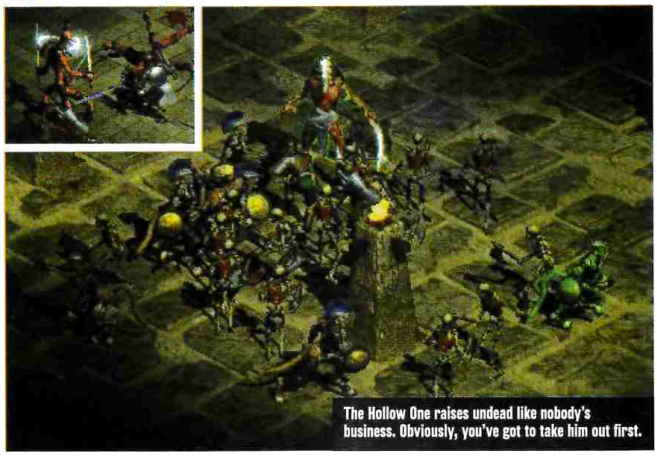Our Verdict
Life-suckingly compelling trinket-gathering action with surprising depth.
PC Gamer's got your back
To mark the launch of Diablo 2: Resurrected, we're publishing our original review of Diablo 2. This review ran in PC Gamer UK issue 86 in September 2000. We're working on a fresh review of Diablo 2: Resurrected now the game is live, and you can find Fraser's impressions here.
My arm hurts. And while there are some things I want to say about Diablo II which are by no means in its favour, my criticisms ultimately count for nothing when set against that pervasive muscular ache. Although I will call it repetitive and unoriginal, claim that it encourages inelegant play, and curse its fetishistic immaturity, the plain, painful fact is that Diablo II is the most brutally addictive game I've played since Half-Life. It devours time. You sit down for a quick play—just to find the next dungeon, you tell yourself; just to get your bearings in the next section—then you regain consciousness with the alarm clock ringing from the bedroom and an arm so tensed from all-night mouse-clicking that it barely feels part of you any more.
The game's fundamental hypnotic appeal is obvious; a tried-and-tested formula. You create a puny and impoverished character, then run around a fantasy world fighting monsters. Your efforts are rewarded with increasingly powerful weapons, armour and magical items, and an alter-ego which grows in ability as he or she gains experience. As the game progresses, then, you get to tackle more powerful monsters… and are rewarded with even heftier power-ups… which enables you to defeat even more powerful monsters… which results in a still further enhanced player-character… and so on.
This is the paradigm for almost every computer role-playing game, from the ASCII-character dungeons of mainframe Hack to the party-based questings of Baldur's Gate. The ongoing incentive is always the prospect of a slightly higher number just around the corner—the Axe of Craftsmanship (Damage 3-12) to supercede your existing Axe (Damage 3-11), or the Glorious Chain Gloves (Defence: 14) to replace the Superior Chain Gloves (Defence: 11). It tends to result in a lot of time spent jiggling inventories and gazing at stat screens, hoarding gold and wondering whether to buy that cool-looking magical weapon from the town merchant, or to wait until you stumble across something even better in some dungeon somewhere.
The genius of Diablo II is that it meets this RPG archetype head on, and does two very different things with it.
My arm hurts so very, very much.
Firstly, it embraces the stereotype, and offers the purest possible implementation of the primal dungeon-crawl experience. Stripped down to the bare essentials, Diablo II is a real-time all-action slaughter-fest with simple point-and-click controls, lots of monsters to kill, and thousands of subtly differentiated items for the player to accumulate and toy with. There's no party to manage, no lengthy conversations to navigate, just your single all-conquering hero. Half a dozen non-player characters mooch about towns offering services on request, but none have any real personality—they're just vending machines on legs. Once out of town, everything you'll encounter is unequivocally 'bad' and must be swiftly dispatched to Hell; the quests which structure progression through the game are all, basically, "go to this place and slay everything you find there." (The places tend to be called things like "The Den of Evil"—no, really.)
In classic fashion, you'll trade items back at the town, and upgrade your character's capabilities with every increase in level. As you start to care for their development, you'll really begin to appreciate the enormous selection of items on offer in the game, and find yourself getting quite anxious as you choose whether or not to make room in your inventory for the Triumphant Claymore—which would mean ditching the Platinum Spetum of Bashing you've been carrying around (and I'm not making these up).

However unoriginal this kind of structure might be—and it is quite staggeringly unoriginal—there's no doubting its compulsive attraction. And developers Blizzard North certainly knew what they were doing: the game runs slickly and smoothly (bar the slightest occasional judder around steps and levels). with intuitive interfaces and lots of neat touches (which I'll talk about in more detail later). Excellently, there's never any unnecessary pause in the action. There are no loading breaks as you move from one map area to another, and the play window remains active in half of the screen as you browse inventory and character-management windows in the other half.
Now that's all well and good, as far as it goes—but it hardly screams "Game of Distinction". It is, as I suggested earlier, fundamentally repetitive. It substitutes an obsessive fascination with objects for engaging narrative, and rewards bloodyminded perseverance over élan. Whether you're hacking at a Huntress with a Hand Axe for two points of damage per strike, or laying into her with a Howling Grand Scepter of the Glacier for a one-hit kill, you're still just pointing at the creature and clicking the mouse button. Your on-screen character may have got more skillful, but you haven't.
Without interrupting the relentless beat of the game's dungeon-crawl heart, however, Blizzard have crafted Diablo II into something altogether more satisfying, pushing beyond the archetype to create a game of surprising subtlety. Executed with the trademark Blizzard attention to detail, it turns out to be a far better game than we had any right to expect.
The main factor in Diablo II's success is the genuine flexibility it affords you in character development. There are five different classes to choose from, and each one is radically different—not just in its balance of statistical attributes, but in the availability of additional skills, which make a real difference to the way in which any particular character will play.

The four basic stats—Strength, Dexterity, Vitality and Energy—are modified as you gain experience points, and affect conventional attributes such as attacking and defensive prowess, your ability to wield certain weapons, your Life (hit points) and Mana (spell and skill ability) totals. At the same time, each character class has a set of unique skills, which can be learned and developed through the careful allocation of skill points. There are 30 skills available to each class, and the more points you allocate to each skill, the more effective it becomes—but, and this is the interesting bit, these points are hard to come by, especially later in the game. You only earn one skill point for each level your character develops, making every choice highly significant. The areas in which you decide to specialise will determine your character's tactics throughout the adventure.

This review first ran in the September 2000 edition of PC Gamer UK. Here are some other reviews from that month, and what we said:
Grand Prix 3: 95%
"Not just the best F1 sim this year, but also the best game we've played in a long time."
Icewind Dale: 84%
"Epic dungeon-crawling which falls below the high standard set by its inspiration."
Kiss Psycho Circus: The Nightmare Child: 80%
"A real back-to-basics shooter that manages to put the horde back where it belongs."
Pompei: The Legend of Vesuvius: 29%
"Takes tedium to new depths. Friends, Romans, countrymen: don't buy this game."
For example: I played my main singleplayer game as a Paladin, and one of his very earliest optional skills is Smite, the ability to bash an opponent with his shield. If successful, it knocks the enemy backwards and stuns them. The more points you assign to this skill, the more damage your blow will cause and the longer the opponent will be stunned, so I poured skill points into this one speciality, even though it seemed a bit useless at first, until it became a highly effective tactic. Large, powerful creatures could be easily dealt with by repeated Smiting, unable to land a blow on my Paladin as they remained stunned throughout the encounter.
However, this decision had numerous side-effects. It meant that I committed myself to melee combat, rather than ranged attacks, and neglected another useful Paladin ability: the Holy Bolt, which strikes down Undead creatures from a distance. And because I had now to carry a shield at all times, it ruled out the use of any two-handed weaponry, so I had to focus on finding the very best one-handed weapons. It also meant that I failed to develop any special defensive skills. Complemented by a magical shield, however, which I had specially engineered for the purpose by a friendly blacksmith, it remained a highly useful special move. (Although not as useful as Zeal—but that's another story...)
Similarly, an Amazon player must decide early on whether to specialise in arrows, spears or javelin, while a Barbarian has to stick to a couple of preferred weapon classes, and decide whether to play with a one-handed weapon and shield or work on his Double Swing move and wield two single-handed weapons simultaneously. Skills are arranged in a tree-like structure, with advanced moves developing from earlier skills, so every player will naturally find themselves focussing on one or two areas at the expense of others.

Alongside this genuinely 'role-playing' side of Diablo II, the massive variety of items available in the game contributes to a real strategic sophistication. There is never any ultimate 'best' weapon or armour; your needs will be determined by your character's individual strengths and the kinds of monsters you anticipate, as well as personal preference, the extreme rarity of particular items, and their capacity for modification. Certain items can boost attribute statistics, or are specially designed to enhance particular class skills, so you're continually faced with interesting choices. The fact that you can only store a very limited amount of equipment, so find yourself constantly discarding items even though they might one day prove invaluable, adds further richness. As does the appearance of socketed items, into which rare jewels can be inserted to give them magical powers at your discretion.
The low-res graphics are disappointing at first.
As your appreciation of character strategy deepens, so too does your awareness of Diablo Il's tactical smartness. Merely walking around holding down the mouse button to attack the nearest monster simply won't work. You'll gradually learn to switch weapons and skills to maximise your effectiveness against different kinds of enemies during an encounter, work out when to use restorative potions and when to retreat, and come to admire the well implemented Stamina feature.
Holding down the Ctrl button while moving enables you to run for as long as your stamina bar holds out—and the tactic continually proves invaluable, as you zip past the onrushing demon hordes to attack their rear-lurking leader and neutralise his ability to raise slain minions from the dead. Or simply dash through a dungeon past legions of bad guys, desperately low on health and heading pell-mell for the exit.
There are many other great things about Diablo II. The opening section of the game (it's divided into four separate Acts) may be a touch uninspired, but the next three are much more interestingly constructed, with their own very distinctive look and feel. There are some impressive monster characterisations amongst the familiar skeletons, zombies and spiders, and the music's good enough not to turn off.

The fixed perspective and low-res graphics (immutably set at 640 x 480) may appear disappointing at first, but they're clear enough, and enlivened by some brilliant touches. Spells and other magics conjure some truly spectacular special effects; real-time lighting ensures that a burning corpse will illuminate the walls most pleasingly; there's some nifty parallax if you've got a good 3D card, and weapons and armour of all types are all depicted on your character sprite, giving them a truly individual appearance. Best of all, perhaps, is the superimposed automap, an invaluable aid which never obscures the action.
Finally—and, perhaps most contentiously—the most compelling of all Diablo Il's features is its save-game implementation. After so many recent PC games whose atmospheres are continually upset by 'save-anywhere' interruptions, Diablo Il's no-save structure comes as a real breath of fresh air—and certainly contributes to that up-all-night tension.
There is no 'save' key. But when you quit the game, your character's status is preserved, along with their currently-held equipment and the gold and items you've placed in your lockable stash in town. When you start up again, your character will be back in town, and all monsters will have respawned. A network of waypoints enables you to teleport to any previously visited area—but major treasures and quest endings are always at least a dungeon-level's worth of monsters away from the nearest waypoint. If you get killed, you lose a chunk of any cash you were carrying and start back at the nearest town without your equipped items. You can then go back and recover those items from your corpse or, if you're unable to fight your way back, you can quit the game, sacrifice all the gold you were carrying, and restart with your corpse safely placed within the town perimeter.

It sounds a bit complicated, but it works well. The main weakness, of course, is that a careful player will rarely lose much more than a few minutes' bother over a death—but the main strength is a removal of that 'just-saved' safety-net from all game choices. You're forced to think much more seriously about major choices than you would in a conventional save-anywhere game. And that can only be welcomed.
With doom lurking around every corner, then, Diablo II tends to foster conservative play. As you get obsessive about the size of your stash, you'll find yourself repeatedly teleporting from dungeon to town to bank every last bit of treasure and ensure you're always in tip-top shape for the next encounter. This can get a bit laborious.
And of course Diablo II compares unfavourably with a pure-bred fantasy-set RPG like Baldur's Gate in terms of variety, plot and dialogue. But the model here is Gauntlet, not Black Isle's recent forays into the genre. It's designed to be an accessible action-RPG with mass-market appeal, a compelling multiplayer mode and long-lasting depth. And on those terms it succeeds magnificently.
The excellently differentiated character types, and the fantastic breadth of skills available within these classes, makes this a game which is genuinely worth playing several times over, trying different characters and tactics each time. In fact, I'd play it from the beginning again right now—as a Sorceress, this time—were it not for the fact that my arm hurts so very, very much…
Life-suckingly compelling trinket-gathering action with surprising depth.


